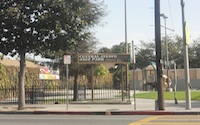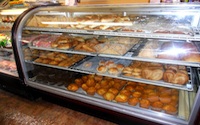
Historical Dunbar Museum
The Dunbar Hotel used to contain a museum with interesting quotes and artifcats from the days of its height. (Photo courtesty of UCLA Special Collections).

The former Hotel Somerville will be renovated as part of the Dunbar Village project, a joint venture by Coalition Responsible Community Development and Thomas Safran and Associates.

Get a glimpse of the Dunbar Hotel from the past, the present and the future.

Several residents express discontent over the renovation of the Dunbar Hotel. Instead, they wish the government would clean up the streets and heighten police enforcement.
By Jenny Chen
USC Annenberg School for Communication & Journalism
Boarded up dusty windows. Rusty locks. Broken panels.
That's all that anybody walking down South Central Avenue would see if they even bothered to glance at the building that now stands broken and deteriorated on the corner of 41st and Central.
In the 1930s, it was the place to be. It was built in 1928 by civil rights activist and educated man; John Somerville, University of Southern California's first black graduate, not only founded Hotel Somerville but he co-organized the Los Angeles branch of the NAACP.
For some time, the hotel was the only one receptive toward African Americans in Southern California. It quickly became a meeting point for African Americans. It didn't take long for the building to fill up.
Following its grand opening, it held the West Coast's first NAACP convention with guests such as W.E.B. DuBois and William Pickens.
In 1929, Somerville suffered from the market crash and was forced to sell the hotel to white investors. The hotel was renamed Dunbar in 1929 in homage of poet Paul Laurence Dunbar.
In 1930, gangster Lucius Lomax purchased the hotel. In 1934, hotel ownership switched hands again as Father Divine's Peace Mission Movement took over.
In the late 1930s, the Dunbar was sold to the Nelson family and it once again became a center for African American culture.
By the 1950s, as racial integration was slowly introduced, business at the Dunbar Hotel slowed down.
While Central Avenue is sometimes critiqued now as dirty streets with dirty crime, it used to be a hub for black entertainers, writers, musicians and more. Count Basie, Cab Calloway, Langston Hughes and Duke Ellington are all former visitors of Central Avenue and the Dunbar Hotel.
Bernard Johnson purchased the hotel in 1960 with hopes of adding a museum. Following his ownership, the building fell into disarray and the building turne dvacant.
In 1974, it was declared a city landmark by the Los Angeles Cultural Heritage Commission. In 1976, it was added to the National Register of Historic Places.
It took another decade for the non-profit Dunbar Economic Development Corporation to develop with the sole purpose of restoring and maintaining the landmark. In 1989, the Dunbar Hotel Apartments opened with 73 apartments suited for low-income residents. There was also a museum and a senior center.
Currently, it has fallen victim to a lack of interest and the deteriorating community inside and outside the hotel. Graffiti adorned the walls and the museum closed.
In 2011, the Coalition for Responsible Communiy Development, Los Angeles Housing Department, and Thomas Safran and Associates teamed up with the support of Councilwoman Jan Perry to rehabilitate and develop the Dunbar Hotel along with its adjacent apartment complexes to create the Dunbar Village.
The Dunbar Village is set to begin construction in December 2011.
Below is a five-minute tour of the Dunbar Hotel.
(Credit: adodom via YouTube)

